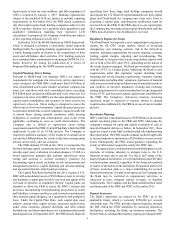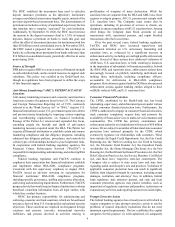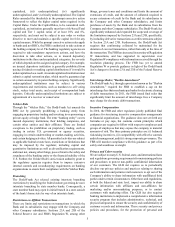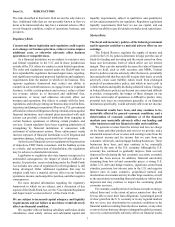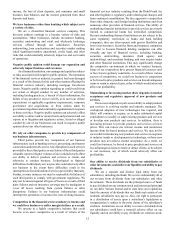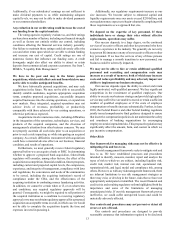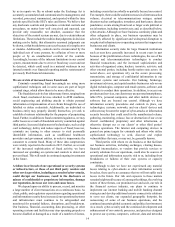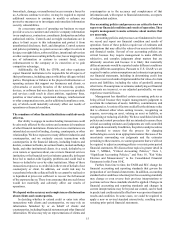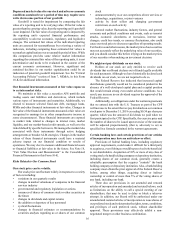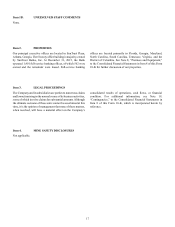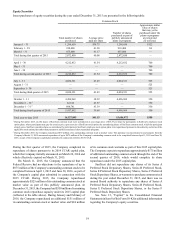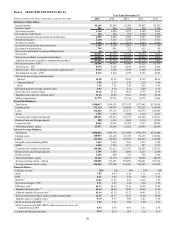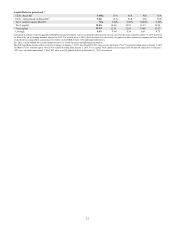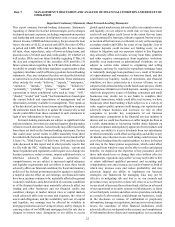SunTrust 2015 Annual Report Download - page 40
Download and view the complete annual report
Please find page 40 of the 2015 SunTrust annual report below. You can navigate through the pages in the report by either clicking on the pages listed below, or by using the keyword search tool below to find specific information within the annual report.12
income, the loss of client deposits, and consumer and small
business loan balances and the income generated from those
deposits and loans.
We have businesses other than banking which subject us to
a variety of risks.
We are a diversified financial services company. This
diversity subjects earnings to a broader variety of risks and
uncertainties. Other businesses include investment banking,
securities underwriting and retail and wholesale brokerage
services offered through our subsidiaries. Securities
underwriting, loan syndications and securities market making
entail significant market, operational, credit, legal, and other
risks that could materially adversely impact us and our results
of operations.
Negative public opinion could damage our reputation and
adversely impact business and revenues.
As a financial institution, our earnings and capital are subject
to risks associated with negative public opinion. The reputation
of the financial services industry, in general, has been damaged
as a result of the financial crisis and other matters affecting the
financial services industry, including mortgage foreclosure
issues. Negative public opinion regarding us could result from
our actual or alleged conduct in any number of activities,
including lending practices, a breach of client information, the
failure of any product or service sold by us to meet our clients'
expectations or applicable regulatory requirements, corporate
governance and acquisitions, or from actions taken by
government regulators and community organizations in response
to those activities. Negative public opinion can adversely affect
our ability to attract and/or retain clients and personnel and can
expose us to litigation and regulatory action. Actual or alleged
conduct by one of our businesses can result in negative public
opinion about our other businesses.
We rely on other companies to provide key components of
our business infrastructure.
Third parties provide key components of our business
infrastructure such as banking services, processing, and internet
connections and network access. Any disruption in such services
provided by these third parties or any failure of these third parties
to handle current or higher volumes of use could adversely affect
our ability to deliver products and services to clients and
otherwise to conduct business. Technological or financial
difficulties of a third party service provider could adversely affect
our business to the extent those difficulties result in the
interruption or discontinuation of services provided by that party.
Further, in some instances we may be responsible for failures of
such third parties to comply with government regulations. We
may not be insured against all types of losses as a result of third
party failures and our insurance coverage may be inadequate to
cover all losses resulting from system failures or other
disruptions. Failures in our business infrastructure could
interrupt the operations or increase the costs of doing business.
Competition in the financial services industry is intense and
we could lose business or suffer margin declines as a result.
We operate in a highly competitive industry that could
become even more competitive as a result of reform of the
financial services industry resulting from the Dodd-Frank Act
and other legislative, regulatory, and technological changes, and
from continued consolidation. We face aggressive competition
from other domestic and foreign lending institutions and from
numerous other providers of financial services. The ability of
nonbanking financial institutions to provide services previously
limited to commercial banks has intensified competition.
Because nonbanking financial institutions are not subject to the
same regulatory restrictions as banks and bank holding
companies, they can often operate with greater flexibility and
lower cost structures. Securities firms and insurance companies
that elect to become financial holding companies can offer
virtually any type of financial service, including banking,
securities underwriting, insurance (both agency and
underwriting), and merchant banking, and may acquire banks
and other financial institutions. This may significantly change
the competitive environment in which we conduct business.
Some of our competitors have greater financial resources and/
or face fewer regulatory constraints. As a result of these various
sources of competition, we could lose business to competitors
or be forced to price products and services on less advantageous
terms to retain or attract clients, either of which would adversely
affect our profitability.
Maintaining or increasing market share depends on market
acceptance and regulatory approval of new products and
services.
Our success depends, in part, on our ability to adapt products
and services to evolving market and industry standards. The
widespread adoption of new technologies has required, and
likely will continue to require, us to make substantial capital
expenditures to modify or adapt existing products and services
or develop new products and services. In addition, there is
increasing pressure to provide products and services at lower
prices. This can reduce net interest income and noninterest
income from fee-based products and services. We may not be
successful in introducing new products and services in response
to industry trends or developments in technology, or those new
products may not achieve market acceptance. As a result, we
could lose business, be forced to price products and services on
less advantageous terms to retain or attract clients, or be subject
to cost increases, any of which would adversely affect our
profitability.
Our ability to receive dividends from our subsidiaries or
other investments could affect our liquidity and ability to pay
dividends.
We are a separate and distinct legal entity from our
subsidiaries, including the Bank. We receive substantially all of
our revenue from dividends from our subsidiaries and other
investments. These dividends are the principal source of funds
to pay dividends on our common stock and interest and principal
on our debt. Various federal and/or state laws and regulations
limit the amount of dividends that our Bank and certain of our
nonbank subsidiaries may pay us. Also, our right to participate
in a distribution of assets upon a subsidiary's liquidation or
reorganization is subject to the prior claims of the subsidiary's
creditors. Limitations on our ability to receive dividends from
our subsidiaries could have a material adverse effect on our
liquidity and on our ability to pay dividends on common stock.



